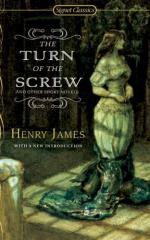|
This section contains 4,389 words (approx. 15 pages at 300 words per page) |

|
SOURCE: “Caste in James's The Turn of the Screw,” in Texas Studies in Literature and Language, Vol. V, No. 2, Summer, 1963, pp. 189–98.
In the following essay, Cranfill and Clark examine James's portrayal of the social power structure in the late nineteenth century.
Henry James took a lively interest in the English caste system of which he was both a part and an observer for most of his life. In “The Real Thing,” published six years before The Turn of the Screw (1898), James conveyed some of his chief ideas about art; but the story also tells much about class and its effects on the British. As James, when planning the tale, indicated in his notebooks, it concerns a faded, impoverished major and his wife who are bested at modeling for an artist by “a common, clever, London girl, of the smallest origin” and by a professional Italian smelling of garlic...
|
This section contains 4,389 words (approx. 15 pages at 300 words per page) |

|


